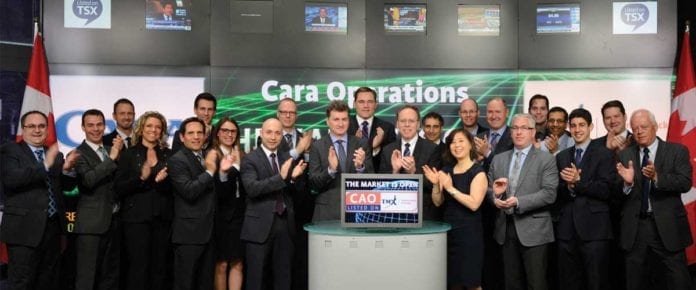When the Phelan brothers started a business selling apples and newspapers in 1883, they likely never imagined their own company would be the one making headlines more than a century later. The Canada Railway News Company — now Vaughan, Ont.-based Cara Operations — had humble beginnings, but in 2015 it solidified its position as a foodservice industry powerhouse.
In April of this year, Cara reappeared on the Toronto Stock Exchange after being taken private in 2004. The initial public offering (IPO) was about 20 times oversubscribed, with investors hankering for shares, surpassing some of the most impressive Canadian IPOs, such as Tim Hortons. Shares sold to early investors for $23 each in the IPO and reached a high of $33.07 on its first day, before closing at $32.90. It was the single biggest increase in share value on the opening day of an IPO since Lululemon Athletica in 2007.
“One of the major reasons we decided to go public was to improve our balance sheet by paying down debt,” says Cara’s president and CEO, Bill Gregson. The IPO raised $230 million, and with neither of the company’s two biggest shareholders — Fairfax Financial Holdings and the Phelan family — taking any money off the table, the whole amount was put toward debt. “[Paying down the debt] put us in a favourable position where we can acquire new companies when those opportunities arise,” Gregson says.
Cara has been making news — and acquisitions — for the last two years. In late 2013, the foodservice giant formed a strategic partnership with Fairfax, one of Canada’s leading financial services holdings companies. Fairfax — the company’s single largest shareholder — recapitalized the business by investing $100 million in Cara and selling its interest in Prime Restaurants to the company for $69.6 million. The investment coincided with the appointment of a new management team and board, including Gregson, and the company has since realized a substantial turnaround in profitability.
In December 2014, Cara bought 55 per cent of The Landing Group, a southern Ontario-based, high-volume, upscale casual restaurant concept, and six months later, it also purchased the remaining 45 per cent. Cara is currently Canada’s largest full-service restaurant company, with 10 brands and 837 locations across the country, 89 per cent of which are operated by franchisees. The Cara family of brands includes Swiss Chalet, Harvey’s, Montana’s, Kelsey’s, Casey’s, Milestones, Fionn MacCool’s, Bier Markt, East Side Mario’s and The Landing Group. The company plans to develop 30 to 50 new restaurants per year. In August, Cara announced the acquisition of another hot brand: New York Fries (NYF), which closed on Oct. 31.
While Fairfax and Cara are separate entities, the partnership was strengthened in 2015 as Fairfax acquired a 51-per-cent stake in The Keg Steakhouse and Bar and a 45-per-cent stake in The McEwan Group, which includes upscale Toronto restaurants North 44, Bymark, One and Fabbrica, as well as the posh McEwan supermarkets.
Having so many seemingly competing brands under one umbrella might sound like a recipe for conflict of interest, but Gregson explains that, in fact, it’s advantageous on several levels. “Our brands are separate and distinct. For instance, Swiss Chalet and East Side Mario’s are both family restaurants, but one is rotisserie chicken and the other is Italian,” Gregson says. “Because we have a number of brands, we’re able to provide consumers with sales opportunity advantages and an improved guest experience,” he says. Earlier this year Cara partnered with Scene, a joint venture between Cineplex Entertainment and Scotiabank that is Canada’s largest entertainment loyalty program. Scene cardholders can now earn points whenever they dine at one of Cara’s 800-plus locations.
“We have a great balance sheet and will continue to look for complementary brands to add to our talent pool. For those that are a fit, we provide an opportunity to be a partner in something bigger. For people working in the industry, there are opportunities for learning and teaching as well as opportunities to grow and move up within the business,” says Gregson. Last year, the company reported approximately $1.8 billion in system sales — all sales from all brands, both franchises and corporate locations. “In five to seven years we’re aiming for $2.5 to $3 billion in system sales,” he says. “A lot of that will come from expanding our existing brands, but also from acquisitions.”
Cara’s philosophy isn’t about creating a homogenous foodservice landscape, on either the consumer or industry sides. “When we acquire a brand, we look to keep the talent. They still run their brand and we give them a lot of support and cost advantages. We give them an opportunity to trade ideas with other restaurateurs so they can apply that knowledge to their own brand and make it stronger,” says Gregson. For example, the folks who were running The Landing Group pre-Cara continue to do so now, but with lower costs and a greater amount of money to invest. There are currently three market-leading restaurants in the Landing Group: Williams Landing at Toronto’s Liberty Village, Hunters Landing at Concord CityPlace, Toronto and Harpers Landing, which is located in Oakville, Ont. The boon is evident, with four new Landings being developed in the next year in the Greater Toronto Area — Burlington, Newmarket, Don Mills and a downtown location. NYF will also be run by the same team of people as before partnering with Cara. “In both cases, we’ll take over the back office — IT, accounting, real estate, legal — and allow the restaurant people to focus on building their brand,” says Gregson.
According to Cara’s second-quarter results (ending June 28, 2015), there is strength in numbers. The company reported total same restaurant sales grew 3.2 per cent in the quarter, representing six consecutive quarters of positive growth, and total system sales growth of $19.2 million, or 4.6 per cent, which fuelled a 29.1-per-cent improvement in operating earnings before interest, taxes, depreciation and amortization (EBITDA) compared to the same quarter in 2014.
With all of its growth and success, Cara hasn’t forgotten to give back to the community. In January 2015, the company partnered with the Boys and Girls Clubs of Canada (BGCC), a non-profit organization that helps kids discover their potential through activities that encourage healthy bodies and minds. Cara has pledged to donate $60,000 in its first year with BGCC with plans for even greater support. Individual stores across the country will have opportunities to partner with BGCC branches and give back to their local communities. “It’s important to be good corporate citizens,” says Gregson. “We’ve already run some events and will continue to build a bigger and better partnership with them over the long term.” That’s one more newsworthy accomplishment — and one of which the founding family would surely be proud.
Story By: Lindsay Forsey
Volume 48, Number 9


















